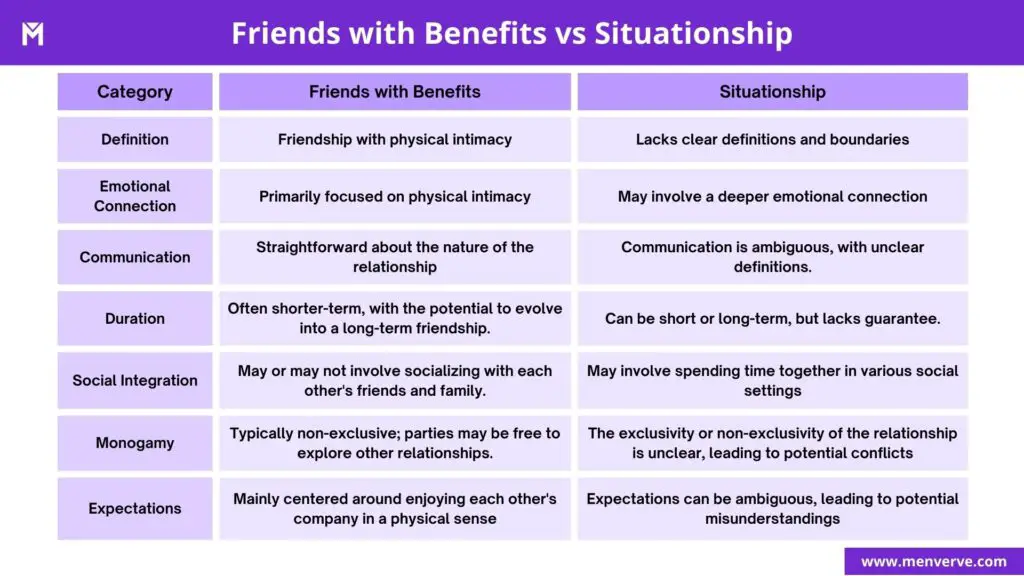In the ever-evolving world of dating, there’s a new player in town – the situationship. It’s not your typical love story; it’s a rollercoaster of emotions, a dance between commitment and casual connections.
The term “situationship” has emerged as a dynamic and complex connection, challenging traditional notions of dating and commitment.

Imagine a relationship where labels take a back seat, and the line between “more than friends” and “something more” blurs.
Get ready for a journey into the heart’s grey zone, where we’ll explore what makes situationships tick and how to navigate the twists and turns of this unconventional love story.
Let’s dive in and decode the mysteries of a situationship and how can one navigate this unique dynamic!
What is a Situationship?
In a world accustomed to neatly defined relationships, the term “situationship” introduces an element of ambiguity and flexibility that defies traditional categorizations.
A situationship is a romantic connection established in the grey area between a committed relationship and a casual fling.
It isn’t a conventional relationship, nor is a genuine friendship.

It’s a unique blend of intimacy and undefined boundaries, where people engage in activities associated with traditional relationships without the explicit labels or expectations.
Unlike conventional relationships or power couple relationships that come with clear titles like ‘boyfriend’ or ‘girlfriend,’ a situationship thrives on the absence of such labels.
This lack of formal definition allows individuals to enjoy the benefits of companionship without the constraints of traditional commitments.

The dynamics of a situationship can range from emotionally rich connections to more physically driven interactions, creating a spectrum of experiences.
People navigate this uncharted territory, embracing the uncertainty that comes with the freedom to explore connections without the rigidity of established relationship norms.
RELATED: Is Flirting Cheating? Here’s the Answer you Need!
Characteristics of a Situationship:
To truly understand the meaning of a situationship, we have to look at the multi-variate characteristics of a situationship.
These characteristics separate a situationship from other forms of relationship in the modern-day dating scenario.

Here are 12 characteristics of a situationship:
1. Emotional Ambiguity:
Situationships are marked by a nuanced emotional landscape.
People may share profound emotional connections without the clarity of defined labels or commitments.
This emotional ambiguity fosters an environment where people can experience a broad spectrum of feelings, ranging from deep affection to uncertainty and introspection.
2. Undefined Duration:
Unlike relationships with predefined timelines, situationships thrive on the absence of a set duration.
People engage without a clear sense of how long the connection will last.
This lack of temporal constraints introduces an element of flexibility but also raises questions about the longevity and sustainability of the relationship.
RELATED: Love from Afar: Is Long Distance Relationship Right for You?
3. Adaptability to Change:
Situationships exhibit a unique adaptability to life’s inevitable changes.
The relationship can flexibly adjust to the evolving circumstances of each individual.
Whether facing career shifts, personal growth, or unforeseen circumstances, the lack of rigid commitments allows people to navigate these transitions more fluidly.
4. Varied Levels of Intimacy:
The intimacy within situationships is multifaceted. Emotional connections can run deep, intertwined with varying levels of physical intimacy.
This versatility allows for a dynamic and evolving experience, catering to the individual needs and desires of those involved.
The spectrum of intimacy fosters a connection that can be both emotionally rich and physically satisfying.
5. Limited Future Expectations:
Situationships are characterized by a lack of pressure regarding future expectations.
People may revel in the present moment without the burden of defining the trajectory of their relationship.
While this lack of future-oriented commitments offers a sense of freedom, it also introduces an inherent uncertainty about where the connection may lead.
6. Intermittent Communication Patterns:
Communication within situationships follows an intermittent pattern.
Unlike relationships with established norms for regular check-ins, people may communicate sporadically.
This sporadic communication reflects the informal and flexible nature of situationships, where people navigate their connection without the constraints of defined expectations.
7. Undefined Boundaries Extend to Social Interactions:
The concept of undefined boundaries in situationships extends beyond emotional and physical connections to social interactions.
People may engage in shared activities or events without the expectations that often accompany more formal relationships.
This flexibility contributes to the unpredictability of situationships, fostering an environment where people can enjoy each other’s company without predefined constraints.
RELATED: What is a Power Couple? (& How to Become One)
8. Potential for Evolution or Dissolution:
Situationships carry the potential for evolution or dissolution.
People may decide to transition into a more defined commitment, recognizing the depth of their connection.
Conversely, they may acknowledge when it’s time to part ways, appreciating the transient nature of their relationship.
The dynamic nature of situationships allows for a range of outcomes based on the evolving needs and desires of those involved.
9. Individual Growth and Exploration:
Situationships provide a unique space for individual growth and exploration.
People have the freedom to understand their own needs, preferences, and boundaries without the constraints of traditional labels.
This lack of formal commitments encourages personal development within the context of the relationship, fostering an environment where individuals can explore and define themselves.
10. Potential for Emotional Rollercoaster:
The ambiguous nature of situationships can contribute to emotional rollercoasters.
People may experience moments of deep connection followed by periods of uncertainty or insecurity.
Navigating these emotional highs and lows becomes an integral part of the situationship experience, requiring emotional resilience and open communication.
11. Absence of Formal Titles:
A key characteristic of situationships is the absence of formal titles like ‘boyfriend’ or ‘girlfriend.’
People may enjoy companionship without the need for defining the relationship in traditional terms.
This lack of formal labels allows for a more fluid and label-free experience, fostering a connection based on shared experiences rather than predefined roles.
12. Varied Definitions for Partners:
Situationships may hold different meanings for the individuals involved.
While one person may view it as a space for casual connection, another may see the potential for a deeper, more committed relationship.
These varying perspectives contribute to the overall complexity of situationships, highlighting the importance of open communication and mutual understanding.
RELATED: 21 Incredible Traits of a High-Value Woman (Find One!)
Pros of Situationships:
Now that we understand what is a situationship, it’s time to look at the benefits of being in a situationship.

Here are 4 pros of a situationship:
1. Flexibility and Independence:
The hallmark advantage of situationships is the freedom they provide. People can enjoy the benefits of companionship without feeling constrained by rigid expectations.
This flexibility allows for personal growth and exploration without the constraints of a traditional relationship.
2. Low Pressure and Expectations:
Situationships thrive on a low-pressure environment. This lack of pressure fosters a more relaxed and carefree dynamic.
With undefined expectations, people can live in the moment without the weight of long-term commitments.
3. Exploration of Self and Preferences:
The ambiguity of situationships creates a unique space for self-discovery.
Individuals can explore their own needs, preferences, and boundaries without the constraints of traditional labels.
This encourages personal growth and introspection as individuals navigate the complexities of their evolving connection.
4. Adaptability to Change:
Situationships exhibit a degree of adaptability to life’s changes.
People may find it easier to navigate transitions without the need for extensive renegotiation of commitments.
This adaptability contributes to the fluidity of situationships, allowing them to weather the storms of life more gracefully than more formal relationships.
RELATED: 100 Dirty Pickup Lines That’ll Make Her Go Crazy
Cons of Situationships:
Now that we understand the pros of a situationship, it’s time to look at the disadvantages of being in a situationship.

Here are 4 cons of a situationship:
1. Ambiguity and Misunderstandings:
The lack of clear boundaries and communication in situationships can lead to ambiguity and misunderstandings.
The absence of explicit conversations about expectations and the future can result in misinterpretations of actions, fostering an environment where assumptions become a breeding ground for confusion.
2. Unequal Expectations:
People in a situationship may enter with differing expectations. While one person may be content with the casual nature of the connection, the other may desire more commitment.
This disparity in expectations can lead to imbalances, fostering emotional strain and potential conflict within the relationship.
3. Emotional Rollercoaster:
The unpredictable nature of situationships can result in emotional highs and lows.
People may experience moments of deep connection followed by periods of uncertainty, contributing to emotional instability.
This emotional rollercoaster can be both exhilarating and challenging, requiring a high level of emotional resilience.
5. Limited Long-Term Security:
Situationships may lack the long-term security and stability that come with committed relationships.
The uncertainty regarding the future can create anxiety for those seeking a more predictable and enduring connection.
This lack of security is a notable drawback for individuals who value stability in their romantic pursuits.
RELATED: 12 Most Important Things in a Relationship
Navigating a Situationship:
Now that we completely understand what is a situationship and what are the benefits and disadvantages of it, it’s time to look at the way through it.

Here’s how you can navigate a situationship if you’re in one.
Open and Honest Communication:
Effective communication is the cornerstone of successful situationships.
People should actively engage in honest discussions about their expectations, boundaries, and feelings.
Establishing a foundation of clear communication is essential for minimizing misunderstandings and fostering a sense of security within the relationship.
Regular Relationship Check-ins:
Given the fluid and evolving nature of situationships, regular check-ins are crucial.
Consistent communication helps prevent potential issues from escalating.
These conversations provide an opportunity for both to assess the current state of the relationship, address emerging concerns, and ensure that both parties remain aligned in their expectations.
Self-Reflection and Awareness:
Successfully navigating a situationship requires a high degree of self-awareness.
People should engage in introspection to understand their own desires, motivations, and boundaries.
This self-reflection allows people to enter the situationship with a clear understanding of what they seek from the connection and promotes healthy communication with their partner.
Establishing Clear Boundaries:
Setting clear and mutually agreed-upon boundaries is crucial in situationships.
Establishing boundaries contributes to a healthier and more respectful dynamic.
Clearly defined guidelines regarding acceptable behavior, expectations, and personal space help prevent misunderstandings and create a sense of security within the relationship.
Understanding the Potential for Evolution:
Acknowledging that situationships can evolve over time is essential.
Individuals should be open to the possibility of the relationship transitioning into a more defined commitment or, conversely, recognize when it’s time to move on.
Flexibility and adaptability to change are vital aspects of successfully navigating the dynamic nature of situationships.
Embracing Emotional Intelligence:
Emotional intelligence plays a crucial role in situationships. People must be attuned to their own emotions and those of their partner.
This awareness facilitates empathetic communication, allowing for a deeper understanding of each other’s needs and fostering emotional connection within the relationship.
Seeking Clarity when Necessary:
While situationships thrive on ambiguity, there are moments when seeking clarity becomes imperative.
If one or both people find themselves grappling with uncertainty, initiating a conversation to define the relationship’s status and expectations can provide much-needed clarity.
Establishing Mutual Goals:
Despite the informal nature of situationships, establishing mutual goals can contribute to a sense of direction within the relationship.
While these goals may not necessarily involve long-term commitments, they can encompass shared experiences, personal growth, or common interests that both people can pursue.
RELATED: 45 Red Flags in Women & How to Spot Them
Situationship vs Friends with Benefits:
As we navigate the complex landscape of modern relationships, it’s essential to distinguish between situationships and friends with benefits (FWB).

While both involve a degree of casual intimacy, they differ in significant ways, shaping the dynamics, expectations, and potential outcomes for those involved.
Let’s delve into the intricacies of each to shed light on the nuanced distinctions.
Situationship
Emotional Ambiguity:
In a situationship, emotional ambiguity is a defining characteristic. People may experience deep emotional connections while simultaneously navigating the lack of clear labels or commitments.
The undefined nature of a situationship allows for emotional exploration without the constraints of traditional relationship expectations.
Undefined Boundaries:
Situationships often involve blurred boundaries, with people engaging in activities that traditionally signal a romantic connection.
However, the absence of explicit discussions about the nature of the relationship can lead to uncertainty and potential misunderstandings.
Potential for Evolution:
Situationships carry the potential for evolution. While they may begin with undefined boundaries, some situationships transform into more committed relationships over time.
This adaptability distinguishes them from more rigid relationship structures.
Communication Challenges:
Communication in situationships can be intricate and complicated.
The lack of clear labels and expectations may create challenges in effectively communicating desires, boundaries, and future expectations, contributing to emotional rollercoasters.
Friends with Benefits
Clear Boundaries:
Friends with benefits are characterized by clear boundaries.
People engage in physical intimacy without the emotional expectations typically associated with a romantic relationship.
The emphasis is on maintaining a casual and uncomplicated connection.
Primarily Physical:
The primary focus of friends with benefits is on physical intimacy.
While genuine friendship may exist, the relationship thrives on the shared desire for casual and non-committal encounters, with emotional involvement taking a backseat.
Consistent Communication:
Friends with benefits often maintain consistent and transparent communication.
Clear expectations about the nature of the relationship, including the desire for casual physical interactions, are established upfront, minimizing misunderstandings.
Limited Potential for Evolution:
Unlike situationships, friends with benefits typically have limited potential for evolution into committed relationships.
The established boundaries prioritize maintaining a casual dynamic, reducing the likelihood of transitioning into a more formal partnership.
How to Navigate Friends with Benefits dynamic:

Define Expectations Early On:
To avoid confusion, people in both situationships and friends with benefits should define their expectations early on.
Open and honest communication about emotional involvement, commitment levels, and future aspirations helps set the tone for the relationship.
Discuss Boundaries Explicitly:
Explicitly discussing boundaries is crucial in both situationships and friends with benefits.
This ensures that all parties involved are on the same page regarding acceptable behavior, communication frequency, and the level of emotional involvement desired.
Be Mindful of Emotional Nuances:
People in situationships should be mindful of the emotional nuances involved.
Understanding and acknowledging the potential for emotional highs and lows can contribute to a more empathetic and supportive dynamic between partners.
Regularly Check In on Relationship Status:
Regular check-ins are vital for both situationships and friends with benefits.
These conversations allow people to reassess the current state of the relationship, discuss any emerging concerns, and ensure that everyone involved remains comfortable with the rules.
Recognize and Respect Differences:
It’s essential to recognize that situationships and friends with benefits serve different purposes.
While a situationship may involve a broader spectrum of emotional connections, friends with benefits prioritize the physical aspect.
Respecting these differences is crucial for fostering healthy and mutually satisfying relationships.
Final Thoughts!
The concept of a situationship represents a modern and evolving form of romantic connection that demands a heightened level of understanding, communication, and adaptability.
While situationships offer unique advantages, such as flexibility and independence, their inherent complexity requires people to approach them with emotional intelligence.
Successfully navigating a situationship entails embracing the uncertainty, fostering open communication, and being attuned to the evolving needs of both people.
Ultimately, the fate of a situationship lies in the hands of the individuals involved, and their ability to navigate the multifaceted dynamics of this distinctive relationship status.
All the best, King!



